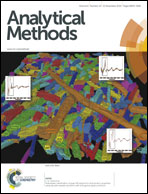Using AuCo alloy nanoparticles/HS-graphene modified electrode for the selective determination of dopamine, ascorbic acid and uric acid
Abstract
An electrochemical method for the selective determination of dopamine (DA), ascorbic acid (AA) and uric acid (UA) was set up using an AuCo alloy nanoparticle/HS-graphene modified electrode. The AuCo alloy nanoparticles (AuCo NPs) were formed on a thiol group functional graphene (HS-GR) modified electrode by an electro-depositing method. The morphology and electrochemical properties of the modified electrode were characterized by scanning electron microscopy (SEM) and electrochemical methods, (such as cyclic voltammetry (CV) and differential pulse voltammetry (DPV)), respectively. The morphology of the AuCo NPs was like a cauliflower. The electrochemical experiments revealed that, on the modified electrode, DA, AA and UA had three separate DPV oxidation peaks in mcilvaine buffer solutions (MBS) of pH 4.5. The peak potential separations of DA and AA, DA and UA, AA and UA were 156, 136 and 292 mV, respectively, which can be used for the selective determination of each of them in their mixture solution. The linear concentration range of DA, AA and UA were 2.1–21.1 μM, 10.0–100.0 μM and 9.0–60 μM, respectively, with the detection limits (S/N = 3) of 0.1, 4.0 and 1.0 μM. The high selectivity and good sensitivity of the modified electrode made it possible to successfully detect DA in human serum samples.


 Please wait while we load your content...
Please wait while we load your content...